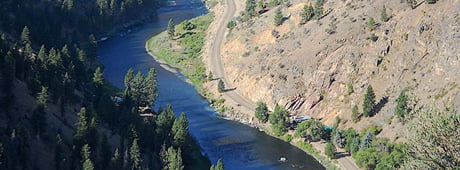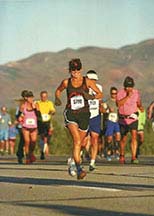No products in the cart.
Shoup—Spotlight City

A Salmon River Haven
By Alice Schenk
Photos courtesy of Alice Schenk
The apples were disappearing quickly from the tree outside the kitchen window at the Shoup store and there was only one way to solve the problem. The bear would have to die. So Dad bought a bear tag and the rest is history. Clever history, at that.
You see, a small orchard and vegetable garden sat on a knoll behind the store. Dad set a ladder in front of the store, which also served as his house. He hung cans on strings, tied the strings in the branches of the apple tree, and then left the kitchen and bedroom windows cracked open during the night. When the cans made noise, he went outside, climbed the ladder to the roof, and soon had a bear rug. And apples.
Another story Dad loved to tell was how he responded when he got bitten by a rattlesnake in the orchard. He hooked his jumper cables to his truck battery and put the other end on the snake bite. Norlyn Pope, a friend who now lives in Shoshone, recalled, “The electric shock was enough to pull the venom out. Don told me that a golden liquid came out where the snake bite was, and other than being sick for a while, he was fine.”
From 1985-1989, my dad, Don Myers, and my stepmom Donna owned and operated the store in Shoup, along the Salmon River in Lemhi County. The townsite’s population was just the two of them, although the store served cabins along the river.
It showcased two fuel pumps with clear glass cylinders on top that allowed customers to see the amount and quality of gas they were getting. They were gravity-flow pumps, because the canyon had no electricity. Donna made and sold homemade bread, brownies, and apple pie.
There was always a gallon jar of pickled eggs sitting on the counter for a buck apiece. They sold tackle, worms, and convenience items.
My dad was the postman. Three times a week, he’d drive about seventeen miles along the steep Salmon River Road to the tiny town of North Fork to get the mail, which he then would deliver up and down the river in his little pickup. There were no newspaper deliveries.
The nearest daily newspaper and large hospital were both in Missoula, Montana, 140 miles north across the steep Bitterroot Mountains. When Dad and Donna lived in Shoup, the area had few if any power lines, the school building at the townsite was closed, there were no churches, and no libraries.
The community’s namesake was George L. Shoup, the last territorial governor and the first state governor of Idaho. The town was established in the 1880s when placer gold and then quartz gold were discovered in what became known as the Mineral Hill District. According to the 1978 book River of No Return by John Carrey and Cort Conley, the district had more than three hundred mining claims by 1890. There were three gold mines, the most productive of which was the Clipper-Bullion Mine.
This content is available for purchase. Please select from available options.
Purchase Only
Purchase Only

